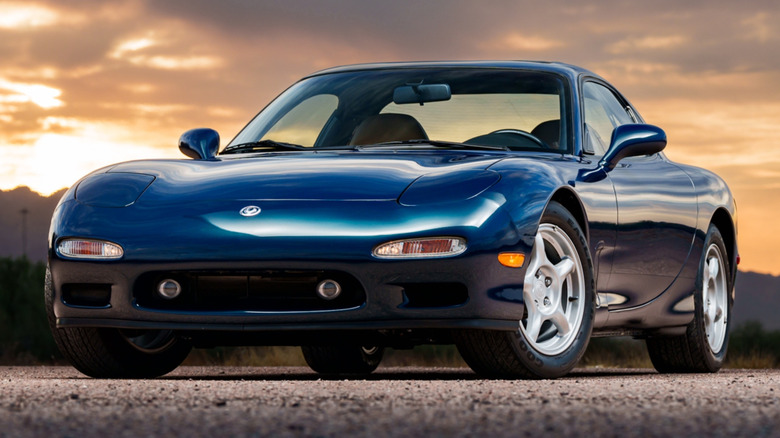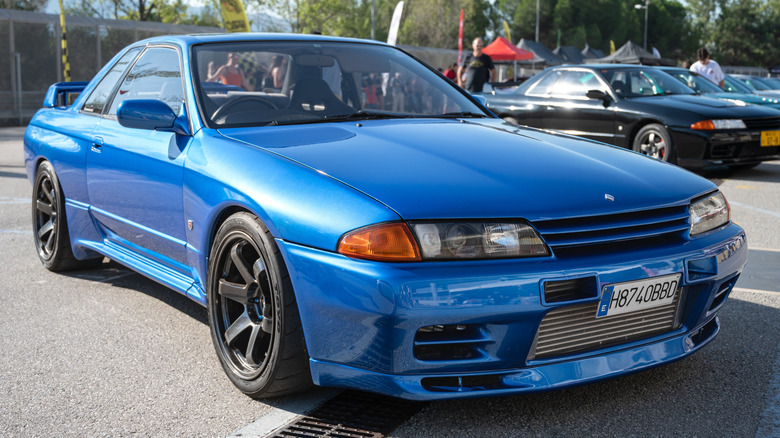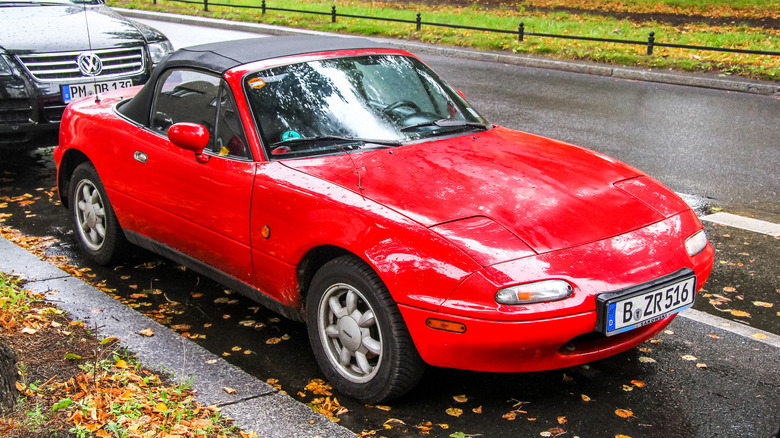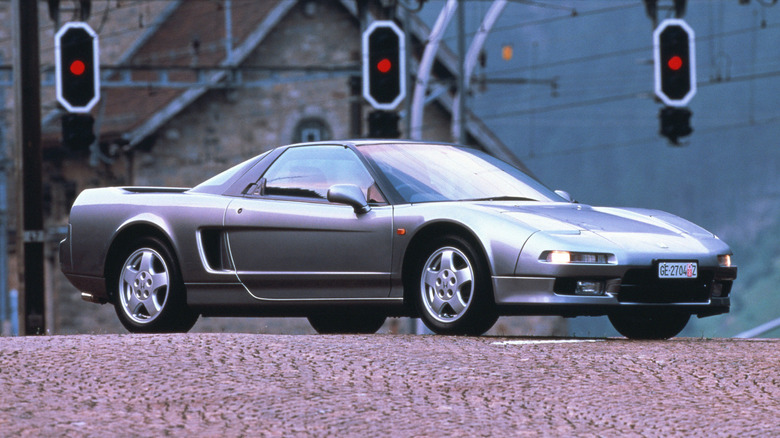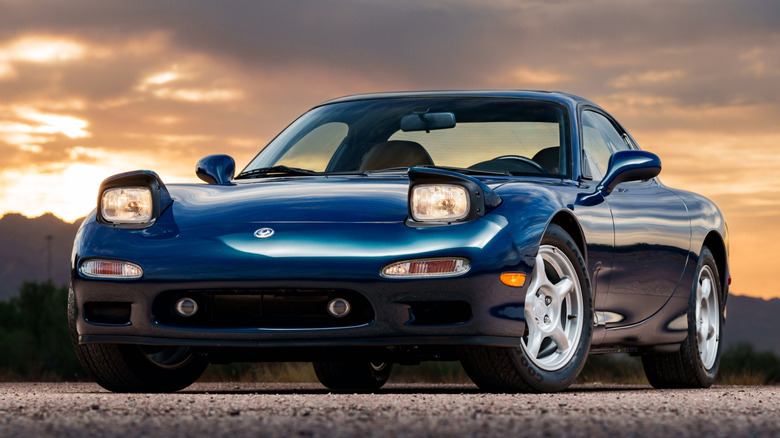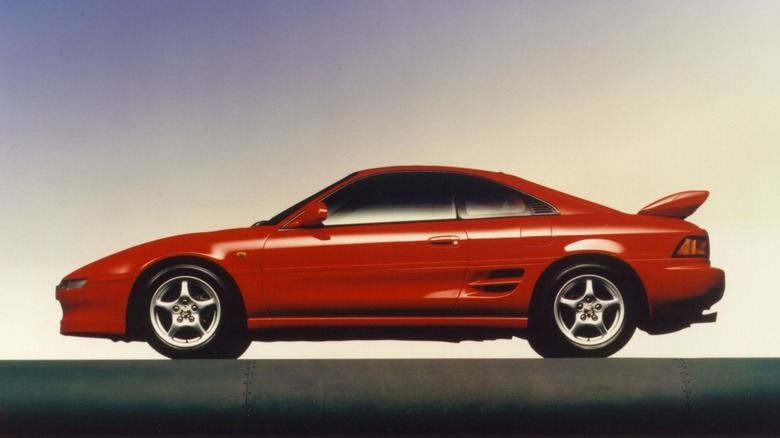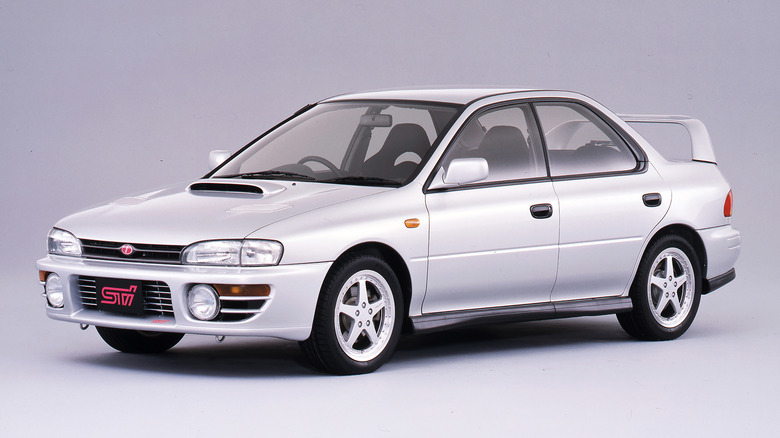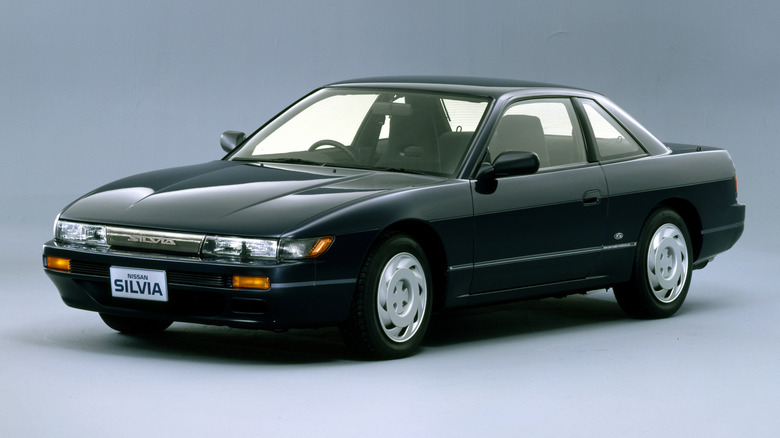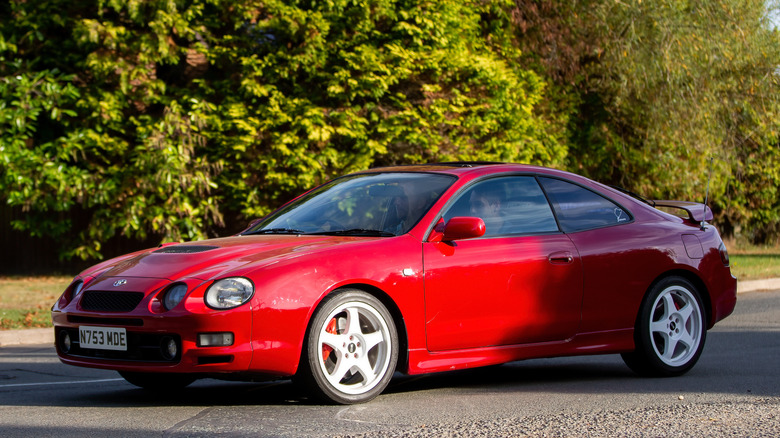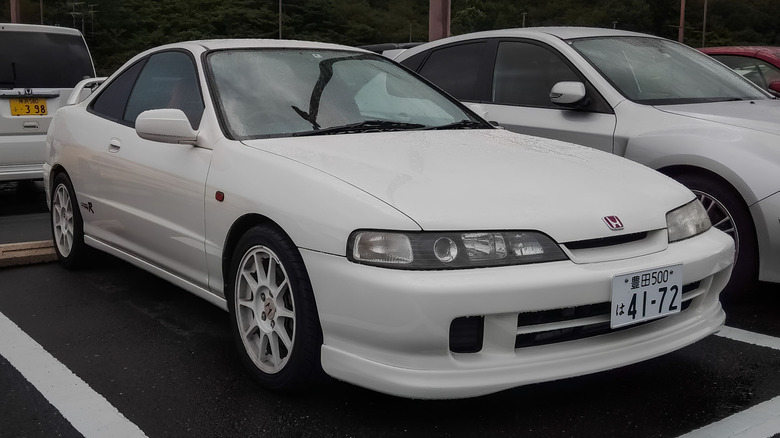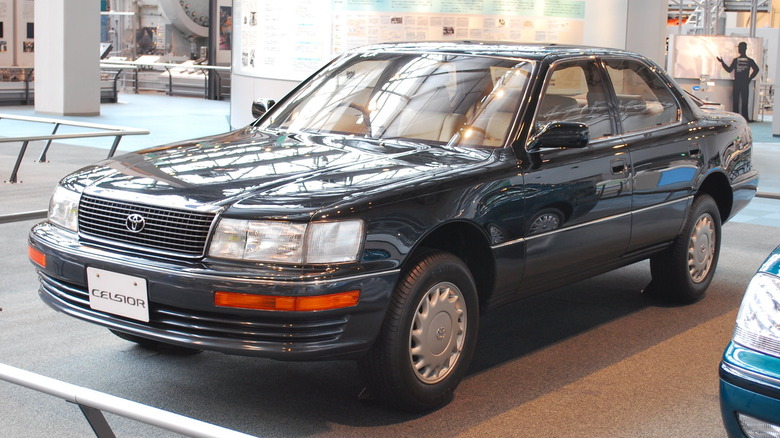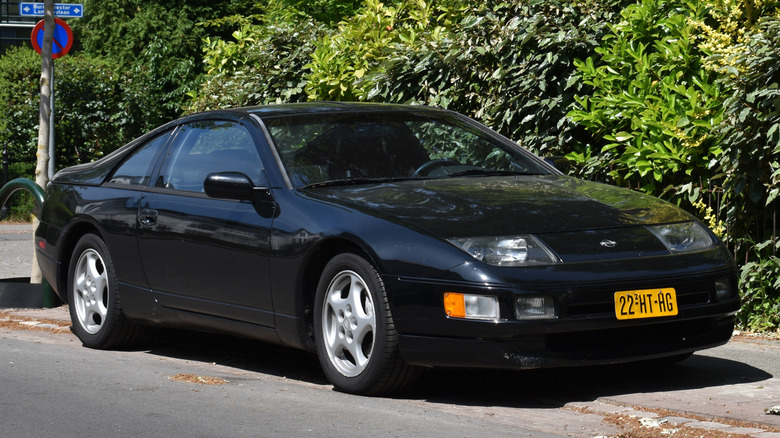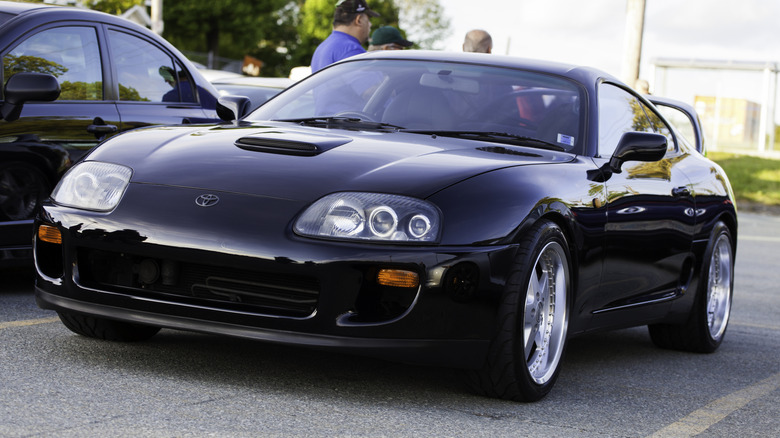12 Of The Greatest JDM Cars Of The 90s
The '90s was a transformative decade for Japan. The start of the decade marked the peak of the country's economic bubble, but by the end of 1990, that bubble had already started to burst. Optimism from businesses and consumers about the future of the Japanese economy quickly disappeared, and many of the country's biggest firms were forced to scale back their development plans. In this context, it's remarkable that Japan also managed to churn out many of its most iconic cars ever during this period.
Japanese carmakers were hit hard by the collapse of the bubble, but that didn't stop them from continuing to develop innovative class-leading cars, many of which went on to garner dedicated fanbases around the world as well as within Japan. Picking which of the many incredible cars of the decade are the most iconic is tricky — there are simply too many candidates to include them all — but for our money, these 12 examples stand out as particularly influential. Each one was a big hit with Japanese buyers, as well as gaining recognition with enthusiasts around the rest of the world.
To keep things simple, this list only includes cars where the majority of their production run took place in the '90s. So, late '90s favorites like the Honda S2000 and Nissan Skyline GT-R R34 are excluded from consideration here.
Nissan Skyline GT-R R32
Few other examples were as critical in forging Japan's reputation for performance cars in the '90s as the Nissan Skyline GT-R R32. The Skyline had been in production in various forms since the '50s, but the R32 generation made it a global phenomenon. The car was launched in Japan in 1989 and featured the RB26DETT engine, which boasted an official power output of 276 hp in line with Japan's gentleman's agreement between manufacturers.
However, it was well known that the engine could be tuned to produce far more power than stock, and better yet, the car's other mechanicals were so over-engineered that they could handle the extra power with very little modification. This tuning potential, combined with the R32's success on the track both in Japan and abroad, saw it explode in popularity with enthusiasts around the world.
Despite being highly popular, the Skyline GT-R R32 was never sold in key markets like the U.S., which helped give it an extra layer of exotic appeal. Here was a car from Japan that could churn out virtually unlimited power with the right modifications and send it to all four wheels, yet it remained forbidden fruit for the world's most influential car market. It's now plenty old enough to be imported under the 25 year rule, but that sense of mystique — and the car's fearsome tuning potential — have remained unchanged over the years.
Eunos Roadster (Mazda MX-5 NA)
Sold as the Eunos Roadster in Japan but known as the Mazda MX-5 or Miata elsewhere in the world, this little sports car made a seriously big impact on the market when it debuted in 1989. Selling over 700,000 units in its first 15 years on sale, its simple but charming formula won over a huge range of buyers.
When it debuted, the Roadster was a breath of fresh air. Many 1980s Japanese sports cars had become bloated and heavy — to take an example, the formerly trailblazing Datsun 240Z of the '60s had evolved into 300ZX Z31, which was described by Car and Driver in 1989 as a "tawdry beast" for the "flabby disco-poseur." It was slow, tech-heavy, and visually unappealing — everything Mazda's little sports car was not.
The Roadster promised driving thrills at speeds that wouldn't risk losing your license, following Mazda's ethos of "jinba ittai." Loosely translated, it means "horse and rider as one," with the focus being the driver's connection to the car and their ability to harness all of its talents. For proof of just how right Mazda got the Roadster/Miata the first time around, just look at the latest iteration of the Miata. It still follows a remarkably similar formula both in its design and its mechanicals, and it's all the better for it.
Honda NSX
Many enthusiasts will already know that the influential Honda NSX inspired the design of the McLaren F1, and forced European manufacturers to step their game up to compete with the upstart supercar. Both the Ferrari F355 and Porsche 911 993 were influenced by the NSX's success, and both proved to be superior cars than their predecessors.
What's less well known is just how many hurdles Honda faced to get the NSX into production in the first place. The design originally started as a technical exercise in the mid-'80s. Experimenting with different powertrain layouts, Honda was particularly impressed by the handling characteristics of its mid-engined prototype. That prototype was no sports car — it was in fact a modified version of the City supermini, the car best known for its association with the Motocompo scooter.
Eventually, the initial prototype was ditched and the decision was made to develop an all-new sports car platform based on an aluminum monocoque body. The material choice was partly inspired by Japan's bullet train, the Shinkansen, which was also made from aluminum. After years of testing, including at the hands of Ayrton Senna, the final NSX design would debut sporting an Acura badge at the Chicago Auto Show in 1989, although Japanese market models would remain badged as Hondas. Production began the following year.
Mazda RX-7 FD
With its unique looks, dual turbochargers and 1.3-liter rotary engine, there's no mistaking the Mazda RX-7 FD. Neither Mazda nor any other manufacturer has built anything quite like it since — even the RX-8 arguably never matched its predecessor. The FD generation RX-7 was first unveiled for Japanese customers in 1991, initially sold as the ɛ̃fini RX-7, and would remain in production until 2002. Over that time, a large number of special edition variants were launched, but the car's distinctive powertrain remained a constant across all of them.
Power output gradually crept up over the years that the RX-7 was in production, although never officially above the 276 hp limit imposed by the Japanese manufacturers' gentleman's agreement. While the MX-5/Miata was Mazda's approachable, best selling sports car, the RX-7 was pitched as a more serious performance tool, popular with enthusiasts both in its stock form and as a tuner car. Its status as one of the most sought-after Mazdas ever built doesn't look set to change anytime soon, and to ensure that examples remain available for future generations of enthusiasts to enjoy, Mazda is reportedly setting up an in-house RX-7 restoration service, although full details of the program have yet to be announced.
Toyota MR2 SW20
It didn't forge quite the same iconic reputation as its more powerful stablemate, the Mk4 Supra, but the second generation Toyota MR2 is still a legend in its own right. It corrected many of the flaws of the original MR2, offering superior comfort and added grunt without compromising on handling. The fact that the MR2 looks a little like the Ferraris of its era is no coincidence — lead designer Kunihiro Uchida deliberately created it that way.
However, far from being just a "poor man's Ferrari," the MR2 is perhaps better described as a Japanese antidote to European sports cars in general. It was designed to be fun to drive, reliable, and reasonably priced, and to look good doing it. In stark contrast to many European sports cars, which infamously required drivers to make some sacrifices — whether in reliability, practicality, or cost — the MR2 was a fun, sporty car that could readily be driven every day. Its popularity and broad appeal has helped keep its resale prices lower than many Japanese contemporaries, but it's no less deserving of its status as one of the most iconic cars of the era.
Subaru Impreza WRX STI GC8
The original Subaru Impreza launched in 1992, but it would take until 1994 for the Japanese market to receive the first Impreza WRX STI. It remained a JDM exclusive, although the WRX would find fame in various global markets. Chiefly, this was thanks to the car's rally success, with the brand winning the World Rally Championship's manufacturers' title three consecutive times between 1995 and 1997, and taking the drivers' crown in 1995, 2001, and 2003.
The road-going WRX STI was the closest Japanese buyers could get to owning the famous rally car, with each car being essentially a standard new WRX that was modified by STI, Subaru's in-house performance division, being fitted with upgraded performance parts before being shipped off to the dealer. Various special editions were also unveiled, culminating in the Impreza STi 22B, widely considered the most desirable Subaru ever built. A prototype 22B owned by Colin McRae sold for £480,500 (a little over $600,000) at a U.K. auction in 2023.
Nissan Silvia S13
Viewed by many outside of Japan as purely a drift missile, the S13 Silvia gained a different reputation with Japanese buyers at its launch. It was considered a "date car," a sporty but fashionable daily driver in the same vein as the Honda Prelude. It was this fashionable reputation that drove its initial popularity, and over the course of its production run between 1988 and 1993, around 300,000 examples would be built. As a result, used examples were both in plentiful supply and cheap to buy, which is where its reputation as a drift car would start to form.
It was unusual at the time for any affordable Japanese car to feature a front-engine, rear-drive (FR) layout, and so the S13 Silvia and its three-door counterpart, the JDM 180SX, became the de facto choice for cash-strapped young buyers looking to shred tires. In particular, post-1991 models with the more powerful 2.0-liter SR20 engine became highly sought after for drifting, and that popularity persists today. It's now significantly harder to find clean, stock examples of the car, and those that do survive can sell for increasingly high prices.
Toyota Celica GT-Four ST185
Subaru and Mitsubishi's rivalry is one of the most famous rallying duels in the sport's history, but Toyota was also a significant force in the WRC before the Subaru/Mitsubishi rivalry hit its peak. The Celica GT-Four ST185 is arguably one of the greatest rally cars ever made, winning three consecutive drivers' titles with three different drivers between 1992 and 1994, a feat that remains unmatched to this day. Toyota's dominance of the WRC would infamously come to an end after the ST185's successor, the ST205, was caught with a cheat device, but not before Toyota had churned out excellent homologation specials of both generations of the Celica.
The first production iteration of the Celica GT-Four launched in September 1989, and boasted innovations such as Toyota's first four-wheel steering system. In order to homologate the Celica competition car, another 5,000 examples of the Celica GT-Four, dubbed the GT-Four RC, were built in 1992.
The Celica rally car proved to be not only fast but unfalteringly reliable, proving its worth on the toughest global rallies like the Safari Rally in Kenya. Buying a roadgoing homologation special gave Japanese drivers a chance to get their hands on some of that battle-proven rallying goodness, and today the car remains a popular classic. Toyota has since reasserted its dominance in the WRC — although a stellar drive from Thierry Neuville saw it miss out on the 2024 drivers' title — and the current JDM GR Yaris is derived from its competition counterpart.
Honda Integra Type-R DC2
Front-wheel drive isn't usually the layout of choice for enthusiasts looking for maximum driver enjoyment. But then, the original Honda Integra Type-R isn't most cars. It's considered to be one of the best handling front-wheel drive cars of all time, with its weight kept to a minimum thanks to a bare-bones interior and its engine making use of Honda's signature VTEC. The latter encourages drivers to keep their foot on the gas for just that little bit longer, pushing the revs that little bit higher in a way that today's economy-focused cars would never condone.
The Integra Type-R launched in Japan in 1995 and remained in production until around the turn of the century, when it was replaced with a new generation Integra. Its stripped-back design had fallen out of fashion by then and remains largely out of fashion today, with the latest Type-R hatchback, the FL5 Civic Type-R, being both much heavier and much more tech-laden than the DC2. It is, however, much faster, with over 300 hp on tap compared to the Integra Type-R's output of just under 200 hp.
Toyota Celsior (Lexus LS400)
Conceived with the global luxury car market in mind, the project known internally by Toyota as "Circle F" would be launched as the Lexus LS400 in America and most other export markets. In Japan, it was sold with a Toyota badge, where it was christened the Celsior. The car was designed to not only take on the leading German luxury car makers, but beat them at their own game. No small feat, considering that the only previous experience Toyota had in making luxury cars was the traditional, stately Century limousine.
The Celsior, by contrast, was a thoroughly modern luxury car, intended to be supremely comfortable, suitably powerful, and unfalteringly reliable. Toyota managed to nail all three of those metrics, particularly the latter — it's not unheard of for examples of the LS400 to hit over 1 million miles. The Lexus brand would not be launched in Japan until 2005, by which time the LS400/Celsior had evolved through several generations. Arguably, none of those generations were quite as important for the company, although the each retained the same basic formula as the original.
[Featured image by Mytho88 via Wikimedia Commons | Cropped and scaled | CC BY-SA 3.0]
Nissan 300ZX Z32
The Z31 generation Nissan 300ZX was saddled with unremarkable performance, dated looks, and clunky electronics — hardly a highlight of the Z line. Nissan's engineers realized that they needed to revamp the car entirely if they wanted it to regain its status as a worthy contender in the sports car world, and so set about creating a car superior in every way. The resulting 300ZX Z32 was packed with innovative features, and it looked sleek to boot.
Four-wheel steering, multi-link suspension, and twin turbochargers all helped the 300ZX force its way back to the front of the pack, providing worthy competition to American favorites like the C4 Corvette. It was far from a cheap car, but at launch it was competitive with what was on the market.
There was no mistaking it for any other car either, as its futuristic, digitally-designed bodywork and pioneering 60-degree slanted headlights made sure that it stood out in the crowd. Those headlights would be so noteworthy that Lamborghini even borrowed them — the post-facelift Diablo's headlights are actually Nissan units, with the Nissan logo covered up by a cleverly placed carbon fiber lip on the Lambo.
Toyota Supra A80
Any list involving the most iconic JDM cars of the '90s would not be complete without the Mk4 Toyota Supra. Its famous 2JZ engine was capable of producing vast amounts of power with relatively few modifications, although even in stock form, the Supra Turbo was mighty fast, with a 0-60 mph time of less than 5 seconds. Officially, the Japanese market Supra stuck to the gentlemen's agreement of producing just under 280 hp, although in certain export markets it was rated as high as 326 hp.
The Supra's popularity at launch was significant, but its popularity with tuners over the following years is arguably what really cemented its legacy as one of the best known Japanese cars of its era. From making star appearances in blockbuster franchises such as "Fast and Furious" to setting highly illegal speed records on U.K. roads thanks to famous speed demon Smokey Nagata, the Supra's place in pop culture is a unique one.
It became so much of an icon that making a follow-up proved extremely difficult — despite Toyota's latest Supra offering drivers the same mix of performance and everyday drivability, it has proved endlessly controversial with enthusiasts, in part thanks to its BMW roots. Whether enthusiasts will warm more to the latest Supra after its production ends remains to be seen, but one thing's for certain: it will never be as much of a legend as the 2JZ-powered Mk4.
